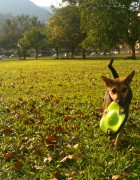On October 12th, in the year of 2004, the Paddy Museum in Kedah was officiated by the State Sultan, and then opened for viewing are the meticulous explanations of what hundreds of husks and grain, so numerous in pixels of brown and white and red will it decorate the 3 main halls of the cylindrical looking structure. Rice, to be sure, is not an uncommon theme in Kedah, already dubbed the “Rice Bowl” of Malaysia due to proliferate culturing of this miniscule but worshipped grass bud.
To have built a museum is perhaps not much of a spectacle, but what is intriguing in this particular museum, is not so much about the content, but what had to happen for a few articles inside to have been produced – the panoramic mural.
On the visitor’s brochure, the introduction will take you up 59 steps ascending to the upper dome of the main hall, telling you that what you would see is in fact the view from on top of Keriang Hill. If you don’t squint, you will take in and “be enthralled” by a 103 metres in length and 8 metres in height of “the traditional village and lush paddy fields (of Kedah). Seats were built onto a revolving platform which inches clockwise so that one could inspect the painting without having to move.
According to the ticketing officer, the mural took the North Koreans 2 years to engage in research done in the form of pictures gathering, and another 6 months to execute the paint pushing. He speculated that the reason why North Koreans were engaged was probably because the project committee couldn’t gather enough local artists to work on this project at that point in time. On another post i have talked about how strange this engagement is, but in this article, i want to show you what the North Koreans produced. Despite the tireless research on “Malaysian” faces, objects and colours, I will try to show you a few comical points that comes through to betray their lack of true interaction with real people while they were here.
The Hilltop View
Given only a casual glance, the mural will immediately impress upon you a rich perspective, colours and a sense of life as if you were looking from the parapets of Notre Dame examining the villagers living obliviously beneath you. Being fantastic with details, and order, everything in the picture speaks of an epoch when everyone has no reason to frown upon their life, every corner a clean and spiritually uplifting sanctuary. Every kid a smile, every now and then a lover, every citizen in all propriety. No wonder the North Koreans were engaged, they were the perfect artist to conjure up this kind of sanctified representations!
Only on close inspection will one begin to see a few things that are unnatural:
Arbitrary Ethnic Representation
Problematic Proximities
Now, in contrast, this is obviously a married couple, and you could observe how different this impression is compared to the 3 couples portrayed above. There is relevance, there is a natural proximity that is not inhibited. The face exhibits a contour of contentment that is matter-of-fact. I could almost feel the artist heaving a sigh of relief. If you’re interested to read more about the pairing process that North Koreans normally have to go through in their tight-rope restrictive country, Barbara Demick’s Nothing to Envy gives a very sophisticated and almost romantic account.
Industrial Idealism
A Strange Marketplace
We would of course take for granted what a marketplace is, and what it means to be walking through one. To the North Koreans they probably had to figure out from photographs what the people were doing gathering in such crowd doing such unfamiliar activities. Would they have been brought into town for orientation for the purpose of realistic representation? I seriously don’t think so. The impression that the paintings tell me that they are copies from stills. Yes there are people walking around, looking at things, holding something, looking into space, appearing pretty, but there is no commercial life. The details of exchange that defines what people do for livelihood, for household maintenance, for exercising purchasing power, the most basic tension of supply and demand that comes out of the street market is starkly missing! The butcher, the piling of fruits, vegetables, all kinds of groceries, the shouting, persuading, bargaining, indulging in egocentric decoration – none of these were drawn! The crowd is only there to cover up what they cannot understand and had no privilege to observe for themselves.
The Smaller Murals
Below the enormous 360 degree mural are other smaller 180 degrees ones. The last one being a montage of important who-and-who’s in Malaysia at the time of painting.
Now What?
According to the ticketing officer, the North Koreans came only to paint the murals. So at least we know that’s the official story. He told me that the building contractors were local. But it will be up to investigation to determine whether or not it was in fact so. But one thing we can be sure of is the presence of North Koreans on Malaysian soil for at least 2 years. I don’t think we were ever been told of their presence, except only after their departure. Whatever happened to them and with them during their stay here was as black a hole as North Korea is without daylight. To an extent, it is quite appropriate to have visitors climb through this make believe cave to get to the revolving mural, because the painting experience was probably as much a job for the artists as well as a sort of introspection, planting in them grains of questions as they try to flesh out what was really under the hill of Keriang. The painting speaks more about who drew it than what was painted. I hope they brought home something with them, however abstract, however strange.





























